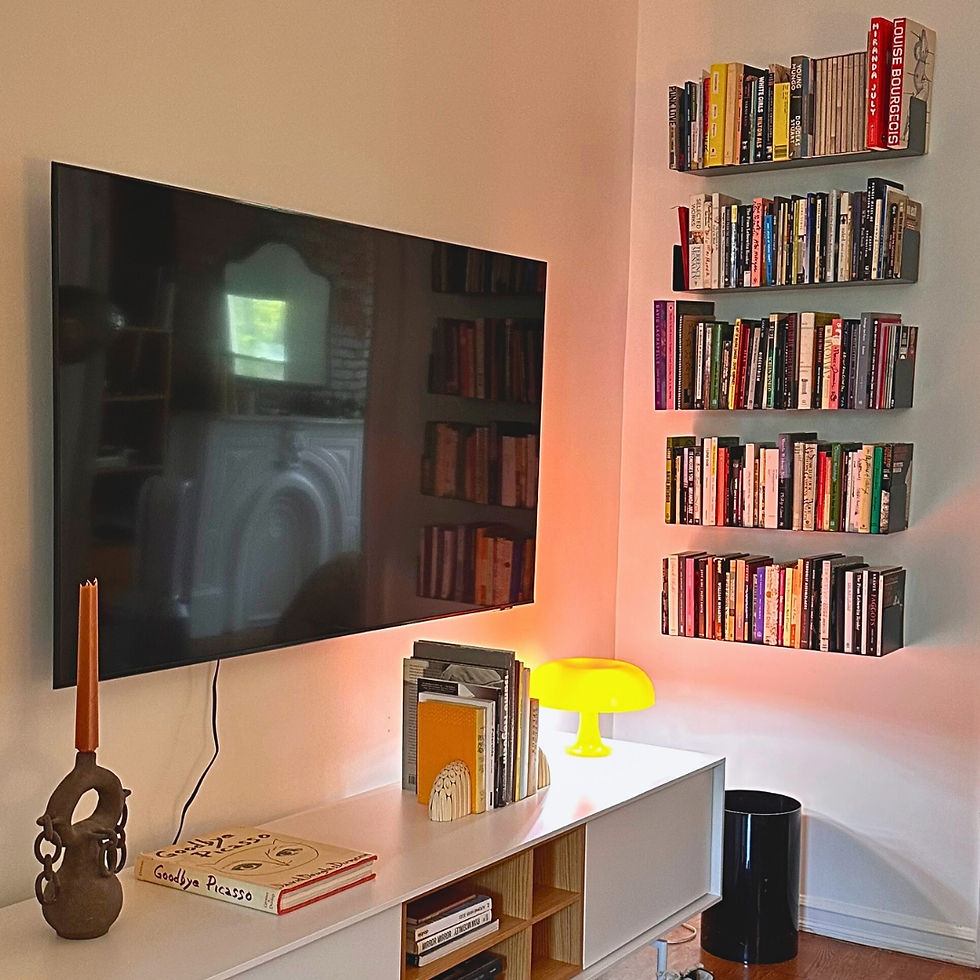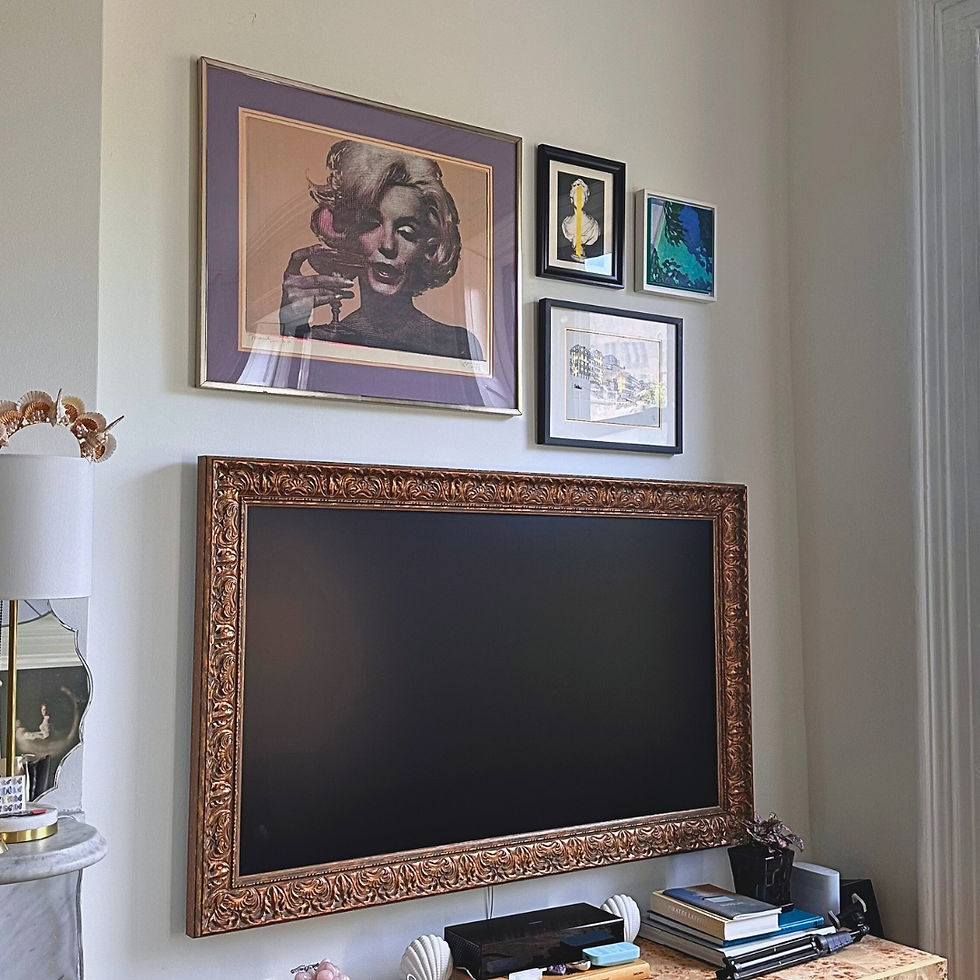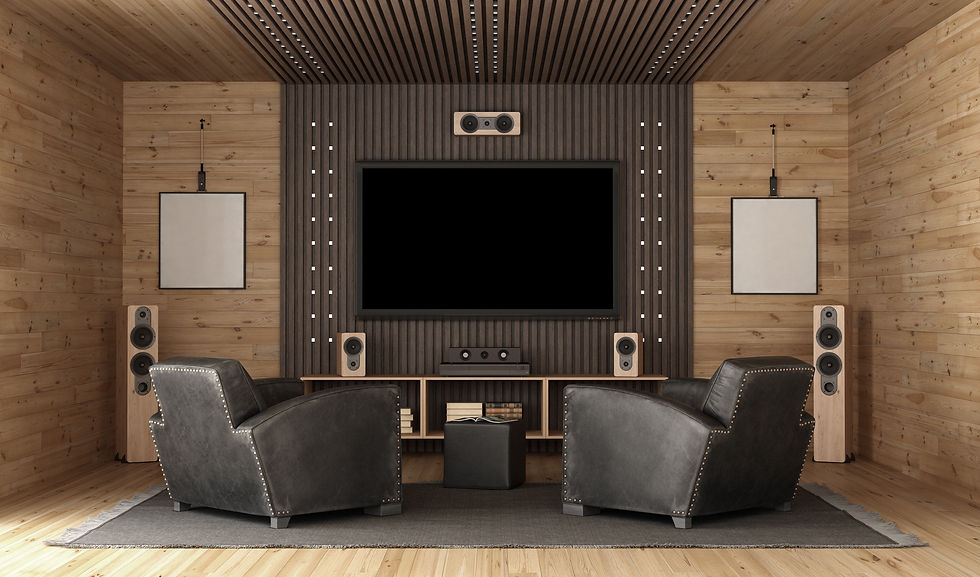TV Mounting. Designer Approach and DIY Guideline
- Orkhan Guliyev

- Dec 8, 2024
- 6 min read
Room Purpose
When choosing a TV for a room, consider its function, lighting, seating arrangement, and activities. For a Living room (LR), which is primarily for entertainment, a 55–85–inch TV is ideal, preferably wall-mounted. Avoid swivel mounts for large screens, as they are visible from most angles and eliminate the need to angle the TV. Regular mounts also reduce the gap between the wall and the TV, enhancing aesthetics.

Regarding Bedrooms (BR), a smaller TV (32–55 inches) works well for casual viewing and relaxation. We typically install the TV slightly above eye level for comfortable viewing while lying down, using a tilt mount for the best angles. This setup allows for a more natural TV-watching experience.
The kitchen (K) is the third most common spot for watching TV and is the primary location for some clients. We recommend small TVs (19–32 inches) for limited spaces. Additionally, Mounts can be adjusted for optimal viewing comfort.
If you want to know more, stay tuned for our upcoming blog post, where we will discuss home theater design and installation. Remember to subscribe!
Room Size / Screen Size

Several factors must be considered when determining the size of a screen, especially the size of the room. Larger rooms can accommodate larger screens, while smaller rooms cannot. Key considerations for functionality include viewing distance, field of view, and aesthetic balance.
What is the Optimal Viewing Distance?
In a small room (6-foot distance), a 40-50 inch TV is ideal. In a large room (10-foot distance), a 65-75 inch TV works better.
In other words, if you have a 4K TV of any size, the distance must be at least 1 to 1.5 times the screen diagonal.
What is the recommended Field of View?
For immersive viewing, the TV should cover about 30–40 degrees of the viewer's horizontal field of vision. Too large a screen in a small room can overwhelm the viewer and cause eye strain, and the opposite can also be true.
What is the Aesthetic Balance?
The TV size should match the room's proportions. A large TV can overwhelm a small room, while a small TV can feel lost in a large space. In My Designer Studio Caspian Pro, I apply the "Rule of Thirds," which suggests that the TV's width should be about one-third the width of the wall or furniture it’s above, like a console or fireplace.
Check the Sound integration and Decor below.
Height and Angle
One of the clients' most common questions is about the ideal height for mounting a TV. The general recommendation is to position the TV at eye level when seated, typically between 42 and 48 inches from the floor. But!
Some clients prefer mounting their TVs higher due to previous experiences, which can create discomfort when viewing at a lower height. However, mounting a TV too high can lead to neck pain, tired eyes, sleepiness, and headaches, especially with low-profile furniture.
On the other hand, If you mount the TV higher, I recommend a maximum height of 52.5 inches. Adding a console or shelf below can create a balanced look. Consider using a swivel mount to easily angle the TV towards your seating or standing, like dining or kitchen.
For more information, the Society of Motion Picture and Television Engineers (SMPTE) recommends a viewing angle of 30 degrees or less to reduce eye strain.
But remember to choose a slim TV with a maximum thickness of 2 inches. This will help reduce aesthetic discomfort when the TV protrudes from the wall due to the swiveled mount.
Lighting
The natural light in a room is crucial for TV installation, affecting viewing comfort and screen visibility. Poor placement relative to light sources can cause glare and eye strain. To minimize these issues, avoid mounting TVs directly opposite windows or bright lights, use tilt mounts to adjust the angle, and consider blackout curtains or shades to control light levels.

Speaking of Artificial overhead lights. It can reflect on the TV screen and create shadows. To fix this, position lights away from the TV’s line of sight and use dimmable fixtures for adjustable brightness.
Nevertheless, a 2018 study by Lighting Research and Technology found that ambient backlighting around screens reduces contrast glare, improving visual comfort during extended viewing. To achieve this, use LED strips or bias lighting behind the TV to create a soft glow that reduces eye strain. You can also install LED light sconces on adjacent walls for indirect light that aesthetically complements the TV setup.
Finally, do not over-illuminate the room, as it competes with the TV’s brightness.
Blend with Decor
A study in the Journal of Environmental Psychology (2020) found that design elements such as symmetry and balance enhance perceived room harmony when technology is integrated subtly.
Furniture Integration
A popular solution for TV design is a media console that matches your room's style, whether minimalist, industrial, or rustic. Custom cabinetry is another common choice, providing space for books and Decor. Lastly, consider adding asymmetrical shelves above or beside the TV for additional decorative items like books and plants, creating a modern aesthetic.

Gallery Wall
Surround the TV with framed artwork, family photos, or prints in matching frames. Use a mix of sizes and orientations for a curated look. Mirrors can also enhance the space by reflecting light and adding character through their material, color, and frame design.
To learn how to design and install Gallery Walls, subscribe to stay tuned.

Panels and Wall treatments can enhance TV setups.
Painting the TV wall a darker color can help reduce screen dominance. Consider using textured wallpaper, wood paneling, or brick for stylish backdrops. Fabric-covered panels improve sound quality in home theaters. Additionally, adding LED strips behind the TV or sconces on either side creates a soft glow; opt for warm or color-changing lights to fit various moods.

Multiple decorative elements would work with a wall-mounted or console-positioned TV. Including but not limited to books, vases, plants, trays, and area rugs. However, to make a sleek and sophisticated look, the aforementioned elements favor sure.
Wall Type and Safety
Hanging a TV can be challenging, especially if you encounter different wall types like Drywall, Brick, or Concrete. Many DIY enthusiasts struggle with this task due to various technical reasons and often damage their walls or equipment, potentially causing injury. Statistics show that nine out of ten DIY attempts don't turn out well, even with instructional videos, primarily because people lack knowledge about their walls. Fortunately, this topic will reveal the secrets of safe TV mounting. Let’s dive in!
The most common wall type in residential interiors is drywall, also known as plasterboard or gypsum board. This type of wall is typically supported by wooden or metal studs underneath. Wood studs may still be present in older townhouses, but modern buildings primarily use metal studs.
This presents a challenge. Previously, studs were spaced closely together, usually 16 inches apart, making it easier to use a stud finder since wooden studs are thicker and easier to detect. However, metal studs, often flat plates, are spaced wider than 16 inches. As a result, many DIY enthusiasts need help finding the ideal position for mounting a TV, often ending up too far left or right.
Even if you locate a stud, drilling into it can be difficult. Metal studs can bend when drilled, and if you do manage to make a hole, inserting an anchor or toggle bolt can be problematic. Additionally, drilling into metal studs at high speeds poses a risk of sparks and potential fire hazards, so caution is essential.
The best approach is to delegate to professionals. Caspian Pro can handle all walls and TV sizes. But if you go by DIY, use 1-2 holes for studs if identified and use multiple points of fixation and a sizeable flat mount with several wall mounting holes, especially for large, heavy TVs. For metal studs, use cobalt tip drill bits. For wood studs, heavy-duty self-drilling screws are sufficient.
When using brick or concrete for DIY, avoid mounting a TV in the spaces between bricks, as this can be hazardous. Instead, always drill through the center of the brick.
Sound System Integration
Regarding sound system integration, we will prepare a separate topic that covers Home Theater Design and Installation.

Mount Type
When choosing a TV mount, there are flat/regular and swivel options, with single or double shoulder designs. Double shoulder mounts offer more stability.
Avoid relying on the TV dimensions listed by manufacturers, as testing methods can vary. Based on our experience mounting thousands of TVs, here are some guidelines:
- For TVs up to 42 inches, use a single shoulder mount on drywall.
- For 46-50 inch TVs, use a single shoulder mount on brick or concrete; avoid drywall.
- For TVs larger than 50 inches, opt for a regular or double shoulder mount.
- Only use regular flat mounts for 70-inch TVs and above; double shoulder mounts can risk drywall damage but are suitable for brick or concrete.
Cable Management
You can conceal cables either in front of the wall or within it. However, clients who rent spaces often need to pay additional fees from their security deposits for the within-wall option due to large holes left behind. While some buildings have pre-installed boxes for easy cable passage, the front-wall option is attractive, safe, and easier to install. Ensure you match colors, as walls are often bluish or yellowish, while concealers are typically pure white. I recommend using black concealers to match your TV and surrounding devices.







Comments